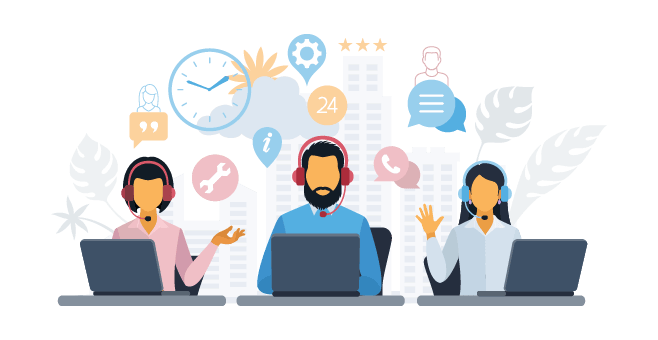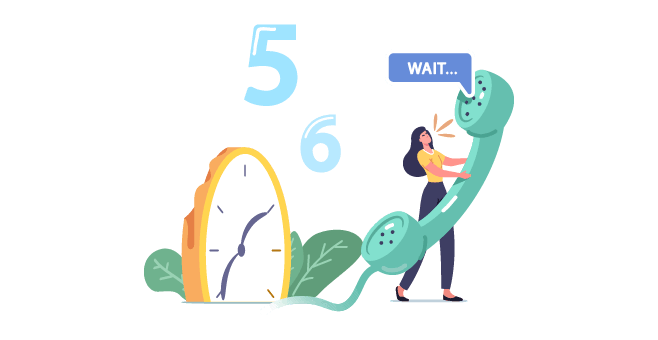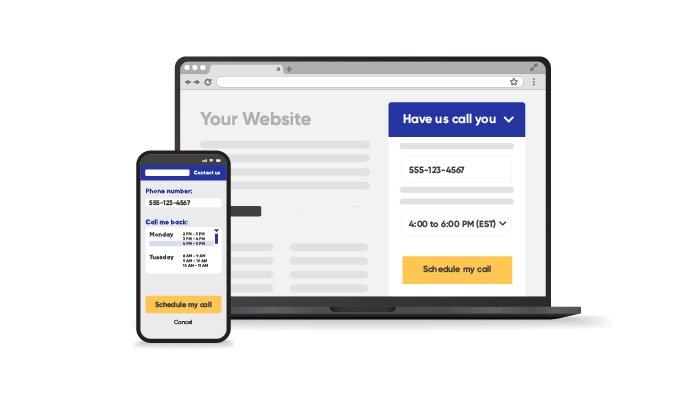The contact center industry boasts some of the most intelligent and innovative CX technologies out there. Visual IVR – now known as Fonolo’s Web Call-Backs – was one of the first self-service technologies to have a hugely positive impact on the customer experience.
If you haven’t yet encountered visual IVR, the first thing to know is that it’s self-service at its best – and quickly becoming an essential tool for businesses that prioritize customer satisfaction and brand perception. Read on for a crash course!
What is Visual IVR?
The original interactive voice response system (IVR) might be better known to customers as a phone menu. This tool gathers customer information and guides callers into the proper phone channels to be connected to an appropriate agent. Almost everyone has used an IVR at some point. This technology is at play when an automated voice answers your call and gives instructions like: “Press one for customer service; press two for accounting,” and so on.

So, we understand IVRs. But what is a visual IVR? Like its predecessor, visual IVR collects customer information and directs customers to the proper channels. Instead of using a voice prompt on a phone call, a visual IVR offers online customers a web menu or a digital mobile interface. This new support experience makes for an easy, frictionless customer journey.
DID YOU KNOW:
Fonolo has offered premium visual IVR capabilities from day one. Today, this product is known as Fonolo Web Call-Backs. Our system is unique because it provides self-contained components that can be dropped into a website or mobile app, making the deployment quite easy.
Why Use Visual IVR Instead of IVR?
Although they can be simple and effective, customers don’t love IVR experiences. Consumers often list dealing with an IVR as a top grievance with the call center experience.
According to a report by J.D. Power and Associates, a good IVR experience is quite rare. They found that IVR is a weak link for most organizations. Their survey revealed that a bad IVR experience makes situations worse and turns neutral customers into dissatisfied ones.
Consumer Reports says that “too many phone steps needed” is the 2nd most common complaint from people. Only “can’t get a human” ranks higher.
But from the company’s point of view, there has to be some way of steering calls to the correct type of agent. If there’s no way for the user to do any “navigation” ahead of the call, odds are the caller will be transferred from one agent to the next – another top complaint in the call center industry.
Visual IVR makes IVR Better
Visual IVR offers a solution for both sides. Callers get an efficient visual interface (instead of “press 1 for this…”), and companies get fewer internal transfers plus happy callers.
How Does Visual IVR Connect Callers to a Live Agent?
Simply put, call-backs are the easiest, most universal bridge between call center and caller. Call-backs remain the chief contender for a solution that works broadly across different call centers and consumer demographics.
That’s why, at Fonolo, we built a cloud-based, industrial-strength, call-back system first. On top of that, we built solutions for each call center channel.
- We built modular components you can simply drop into your mobile app to let your customers request a live-agent call-back directly from your app.
- We built a modular widget that easily integrates with your website and lets online customers request a call-back from a live representative.
What are the benefits of Visual IVR?
Create a seamless omnichannel experience
Customers expect businesses to engage with them wherever they are and carry the conversation between channels. Visual IVR can go one step further and transition your customers from one channel to another. For example, if a customer issue is too complex to solve through self-service, you can offer them a scheduled call-back from an agent. They can use the visual interface to schedule a call-back at a time that works for them.
Better data collection
When it comes to self-service, requesting information through a visual interface is often easier than a traditional phone line. This means higher quality data and more of it — with less room for error.
Direct customers to self-serve tools
While popular with customers, the voice channel is expensive to run and tricky to manage. To lower costs and ease the burden off your agents, visual IVR work with chatbots and intuitive AI technology to answer commonly asked customer questions and encourage customers to use self-service channels, such as an online knowledge base or FAQ.
Make a lasting impression on your customers
According to Hubspot, 89% of customers are likely to purchase multiple times from a company with excellent service. With a stat like that, investing in your customer experience is well worth the investment. Trust us, customers take notice of brands that can take their issue and turn it into a positive and enjoyable interaction.
How Do Visual IVR and Voice Call-Backs Help Reduce Cost-Per-Call?
It’s pretty easy to understand why offering a call-back improves customer experience. Forrester states that 75% of customers think the option of a call-back is “highly appealing”. But visual IVR and call-backs are also a tool to reduce cost-per-call through three mechanisms:
Reduced Abandon Rate
Abandon rate is a metric that many call center managers watch closely. Abandonment leads to higher repeat calls (which can strain the call center system) and, of course, dissatisfied customers. A recent study of 200 contact centers found that when call-backs were added, 32% of the contact centers experienced fewer abandoned calls. When Bright Horizons implemented Fonolo’s visual IVR, their abandon rates fell by a third.
Reduced Handle Time
When customers have to wait on hold, they often take out their frustration on the agent and can be difficult to deal with. Both things increase handle time, which, of course, increases cost-per-call. When Optus deployed Fonolo’s visual IVR, they found that their handle times were reduced by 14%.
Reduced Telco Cost
Finally, call-backs can reduce cost-per-call by making better use of telco resources. With the traditional approach to keeping a caller on hold, a PSTN line is occupied the whole time. Often this is on a toll-free DID, which can carry higher per-minute rates. By replacing hold-time with a call-back, those lines are freed up. When Canadian ISP Allstream deployed Fonolo’s visual IVR to their field technicians, they saw a 35% reduction in cell phone bills
8 Tips for Optimizing Your Visual IVR

Call center agents use visual IVR to reduce wait times.
Optimizing your visual IVR is important for many reasons. This technology has the capacity to ensure a consistent and efficient customer experience. By considering UX, you can ensure your visual IVR is functional and doesn’t interfere with other customer support flows.
1. Don’t just copy your voice IVR.
Setting up your visual IVR isn’t just about repeating your old audio IVR script. You’re creating a different experience completely, and your customers will expect something different as well. Take the time to add a fresh take to your menu options, and think about how those options can better fit with your brand and customers’ needs.
2. Make sure your visual IVR is on-brand.
Your brand includes messaging, logos, color schemes, voice, and more. Essentially, your brand is your promise to your clients. All aspects of your business should incorporate your brand, from your customer service communications, web content, HTML stylings, email signatures, storefront, advertising, and more.
If your brand colors are blue and white, your visual IVR menu design should reflect that. If your company voice is laid back and friendly, make sure the copy in your IVR reflects that as well. Keeping your brand in mind when optimizing visual IVR ensures your customers’ experience isn’t disjointed.
DID YOU KNOW:
Fonolo’s visual IVR, Web Call-Backs, can be customized visually and functionally to suit your contact center needs. Plus, it’s a perfect complement to our call-back technology.
3. Personalize your visual IVR.
We already know that the top reason for customer frustration is not being able to get a human on the phone. As human beings, we value human experiences. Even though you can’t directly speak to a human through IVR, you can still have a personalized experience.
Consider personalizing your client’s experience by adding their name into the prompts wherever possible. Use customer data to tailor your menu options accordingly – this will make your customers feel valued. Don’t offer them options that are inconsistent with their purchase or interaction history.
4. Make it easy to find and use.
If it’s hard to find or use, customers won’t waste their time with it. A complicated visual IVR set up will just increase customer frustration, prompting them to call your contact center instead. This can result in high call volumes and overwhelm for your agents, so it’s worth the effort to create an intuitive experience for your customers.
5. Ask the right questions to help call routing.
Optimize your routing and get your customers where they need to be by asking the right questions. Try to route them to their destination with descriptive menu options catered to their needs and previous interactions.
Another important question you should ask your customers is, “How was your experience?” At the end of the process, offer them a quick survey to show customers that you care about their feedback. This is also a great way to improve your IVR and customer satisfaction.
6. Don’t use it to block contact.
Visual IVRs can be used for call deflection — but that doesn’t mean you should. While this tactic can be used to reduce call volume and inbound calls, it can often backfire, resulting in low customer satisfaction levels.
Rather than forcing your customers into your preferred channel, try meeting them at theirs. Optimizing your visual IVR and other digital channels is a more sustainable way to attract and serve your digital-native customers without sacrificing customer experience for those who prefer the voice channel.
7. Offer customers a call-back.
When it comes to transitioning channels, most businesses with visual IVR technology either offer a phone number for the customer to call or a call-back service. While both are valid options, call-backs are becoming more popular with customers.
Why? Because customers universally hate waiting on hold. By allowing them to schedule a call-back from a live-agent at a later time, you provide a valuable service that will save your customers precious minutes.
8. Test it. (Then re-test it!)
Test your visual IVR technology from the back-end to make sure everything is functioning correctly before going public. This may seem basic, but the last thing you want is for your platform to crash, flooding your voice channel with concerned customers.
When piloting your visual IVR setup, consider the customer perspective. Is it easy to locate on your website and/or app? Is it intuitive and easy to use? Can any of the processes be streamlined? Be sure to consider your most common customer questions – this can help you anticipate which paths your customers are most likely to take. This way, you can easily identify glitches or inconsistencies and optimize the flow as needed.
Call-Backs are the Perfect Pairing for Visual IVR
Call-back technology and visual IVR are a well-known power combo in the contact center world. In fact, Voice Call-Backs address one of the biggest CX challenges not covered by its counterpart: long hold times. With this tool, customers can choose to skip the queue in favor of receiving a call-back later from an available agent. With visual IVR, Call-Backs can be offered on any channel your customer prefers. The results? Higher customer satisfaction (CSat) scores, lower abandonment rates, and improved First Contact Resolution (FCR).

